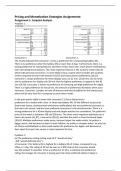Pricing and Monetization Strategies Assignments:
Assignment 1: Conjoint Analysis
Problem 1 :
Consumer 1: Consumer 2:
The results indicate that consumer 1 () has a preference for a long-lasting battery life.
There is no preference when the battery life is lower than 4 days. Furthermore, there is a
strong preference for having features (accelero-meter, heart rate, smart phone notifications)
over not having these features. The most important feature is the accelero-meter (28,13),
which indicates that consumer 1 is more likely to buy a watch which includes the accelero-
meter compared to heart rate monitor (19,37) and smart phone notifications (18,13).
Consumer 1 shows preference for three display sizes; (1) 22 mm, (2) 28 mm, (3) 42 mmm,
and no preference for display size 38 mm. But the highest preference is regards to the 42
mm (18,76). Consumer 1 shows no preference for Samsung and high preference for Apple.
There is a high preference for low prices, the amount of preference decreases when price
increases. Consumer 1 prefers to have all features and best durability for the lowest price,
which will be very hard for a company to serve these needs.
In the part worths table it shows that consumer 2 () has a shared and a
preference for a watch with a two- or three-day battery life. Of the different accessories
(heart rate sensor, accelerometer and phone notifications) the most preferred accessory is
the heart rate sensor, and the least preferred accessories is the accelerometer. There is a
strong preference for a 42mm display and only Apple watches are considered. The preferred
price of the watch is between 199 and 299 euro. The three most important attributes are a
heart rate sensor (21,87), a low price (20,63), and that the watch is from the brand Apple
(20,62). Multiple preferences make sense, because Jasper has wider wrists, he prefers a
bigger watch, and because he doesn’t work fulltime, he prefers a cheaper watch. He also has
an iPhone and MacBook so that could explain the preference for Apple, and because he
does sport the heart rate sensor is most important for him.
Problem 2 :
(a) The preference rating (rating scale of 0 “would not buy”
-100 “would definitely buy”)
of consumer 1 for battery life is highest for a battery life of 4 days, compared to e.g.
12hrs or 1 day. The rating of 30 can be seen as a 30% chance the consumer would
buy the product in question. Since a preference of 30 is a relatively low preference
rating, the changes of consumer 1 buying even the most preferred option (4 days) is
, slim.
(b) For consumer 2, a battery life of 4 days is preferred over other durations such as 12
hours or 1 day. At first glance, this might seem like a similar preference to consumer
1. However, consumer 2 has a 60% likelihood of purchasing the product in question.
This rating is relatively high compared to other ratings and consumer 1's preference,
suggesting that consumer 2 is likely to buy the product when de duration is 4 days.
(c)
Consumer 1 is willing to pay €50 more for 4 days of battery life compared to 2 days.
Consumer 2 is willing to pay €150 more for 4 days of battery life compared to 2 days.
(d) Consumer 1 is €50 more willing to pay for 2 days of battery life compared to 1 day.
Consumer 2 is €150 more willing to pay for 2 days of battery life compared to 1 day.
(e)
WTP for Consumer 1: WTP for Consumer 2:
WTP increase from 12 hours to 1 day: €50 WTP increase from 12 hours to 1 day: €50
WTP increase from 1 day to 2 days: €50 WTP increase from 1 day to 2 days: €100
WTP increase from 2 days to 4 days: €50 WTP increase from 2 days to 4 days: €150
By comparing the increases in WTP, we can observe that Consumer 2 is more sensetive than
Consumer 1 to variations in battery life. This is due to the fact that, in comparison to
Consumer 1, Consumer 2 is willing to pay more for each extra day of battery life. As a result,
Consumer 2 is more price-sensitive about battery life.
Problem 3 :
(a)
€93.92
300 / (0.00 - 27.86) = -10.77
23.01 - 14.29= 8.72





